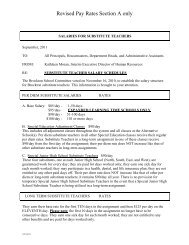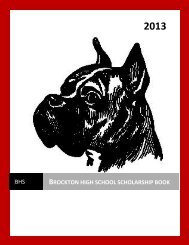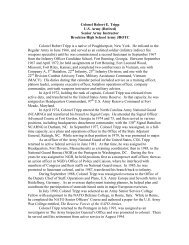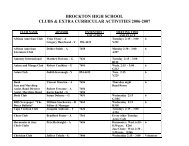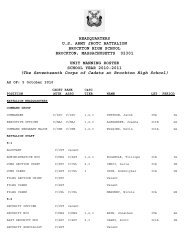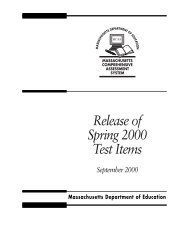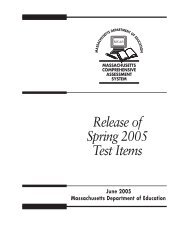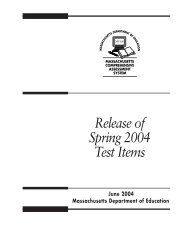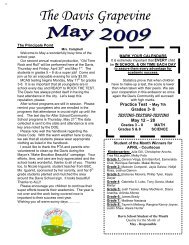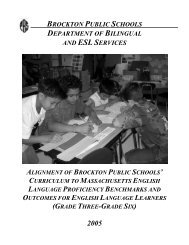Grade 4 Scott Foresman Reading Street Science Alignment Earth ...
Grade 4 Scott Foresman Reading Street Science Alignment Earth ...
Grade 4 Scott Foresman Reading Street Science Alignment Earth ...
You also want an ePaper? Increase the reach of your titles
YUMPU automatically turns print PDFs into web optimized ePapers that Google loves.
Physical <strong>Science</strong><strong>Reading</strong> <strong>Street</strong>Title Level TopicSection4.10 Wind Power above NaturalUsing Natural Resourceson resourcesResourcesbelow4.11 Lighter Than Air above PropertiesProperties of Matteron of MatterMatter’s Propertiesbelow4.12 How Hot? above HeatHeaton EnergyEnergy from Heatbelow4.13 Poles Apart above MagnetsElectricity and Magnetismon andElectric and Magnetic Powerbelow electricity4.15 Newton and Gravity above Force andObjects in Motionon MotionMotionbelow4.1 Tricking the Eye aboveHarry Houdini: The Man and His Magic onTricks to Doing MagicbelowThe Case of the Disappearing Sugar ELL3.12 B Forces and Motion Force and3.12 How things Movemotion3.12 How Bikes Work *3.11 Everyday Reactions Chemistry3.11 B Changes in Matter Matter3.11 Ways Matter Changes3.10 B Matter and Its Properties3.10 How Matter Works3.13 B Energy Energy3.13 So Much Energy3.13 Light *3.14 B Sound3.14 How Sound Works3.14 Sonic Boom ** <strong>Science</strong> ReadersTechnology / Engineering<strong>Reading</strong>Title Level Topic<strong>Street</strong>Section4.14 Movie <strong>Science</strong> above Sound andSound and Lighton LightLight and Sound Wavesbelow
4.16 On the Building Site above MachinesSimple MachinesonUsing Simple Machinesbelow4.19 Great Inventions above TechnologyEffects of Technologyon ImpactTechnology in the Worldbelow4.6.4 The Wheels on the Bike Go Round and Round above TransportationFly Like a BirdonUp, Up and AwaybelowThank You, Sir Isaac Newton!!ELL
<strong>Grade</strong> 4 <strong>Science</strong><strong>Earth</strong> and Space <strong>Science</strong>sTopicWeatherSuggestedDatesWinter/ SpringVarious types ofprecipitationleadsto morehands onopportunitiesLearning Standard6. Explain how airtemperature, moisturewind speed anddirection, andprecipitation make upthe weather in aparticular place7. Distinguish amongvarious forms ofprecipitation (rain, snow,sleet, and hail), makingconnections to theweather in a particularplace and time8. Describe howglobal patterns such asthe jet stream andwater currentsinfluence local weatherin measurable termssuch as temperature,wind direction andspeed, andprecipitationIdeas for DevelopingInvestigations and LearningExperiencesUse a collection of classical (notdigital) weather instruments thatclearly show the physicalprinciple that makes them work.Collection includesthermometer, barometer, raingauge, hygrometer, andanemometer. Note: A“homemade” instrument is oftentoo inaccurate and unreliable tobe a good weather teaching aidby itself. However, when used incombination with a workinginstrument of similar simpledesign, it can help students graspboth an important physicalconcept and its relevance toweather.Measure various forms ofprecipitation. Bring a measuredsample of snow into theclassroom, allow it to melt, andcompare the amount of waterthat results with the originalmeasurement.An activity to illustrateconvection (essential intransferring both heat andmoisture around the world;drives both wind circulation andocean currents.) Freeze a darksolution of food coloring andwater in an ice cube tray. Float acolored ice cube on water in atransparent container. Discusswhat happens, and how it isconnected to convection in bothliquid and gas.ResourcesClassroom Resources:Discover the Wonder Module E-Web:www.edhelper.com – can create ownassessments and activitieswww.weatherwizkids.comwww.ucar.edu/educ_outreach/webweather/Other: Destiny (IRC program) – to searchfor various titles in schoolsLiteracy Closets- will vary among schools<strong>Scott</strong> <strong>Foresman</strong> SS program- use climatemaps and various chapters to read/researchclimatesNewspaper in Education (NIE)Use weather maps to practice reading andforecasting the weatherAssessmentMatching- students canmatch a visual of the toolwith the purposeDiscover the WonderP.E 78 DramaWrite about variousinstruments and explaintheir purposesWrite weather report forgiven map or studentscreate own using symbolsand given FCA’sUse science forms to writeup steps in the scientificprocess when completingvarious experiments ordemonstrations6/22/2010 1
<strong>Grade</strong> 4 <strong>Science</strong>TopicSuggestedDatesIdeas for DevelopingLearning Standard Investigations and Learning Resources AssessmentExperiences9. Differentiate betweenweather and climateSoil None 4. Explain and giveexamples of the waysin which soil isformed (theweathering of rock bywater and wind andfrom thedecomposition ofplant and animalremains).The WaterCycleNone10. Describe how wateron earth cycles indifferent forms and indifferent locations,including undergroundand in the atmosphere.Collect daily temperature andprecipitation data, preferably byobservation, at your school. Atthe same time use the internet ora newspaper to collect the samedata for a nearby city and a cityon the west coast of the U.S.After three months, take variousaverages of the daily data for thethree locations. Graph the data.Discuss how the long-term dailyweather averages begin todescribe each climate.• Observe sand with a handlens. Note how particlesresemble minerals. Observetopsoil with a hand lens.Look for fragments oforganisms. Note differencesin color, texture, odor, andclumping due to organiccomponents vs. pure sand.Mix topsoil and sandtogether in variousproportions to representsamples of types of soils.• Draw a diagram of the watercycle. Label evaporation,condensation, andprecipitation. Explain whathappens during eachprocess.<strong>Scott</strong> <strong>Foresman</strong> SS programDiscover the WonderNewspaper/ internetClassroom Resources:Web:http://www.edhelper.com/<strong>Reading</strong>Comprehension_27_3.html (read and answerquestions)http://www.blm.gov/nstc/soil/Kids/index.html (focuses on the living things in soil andhas many activities, including Make YourOwn <strong>Earth</strong>worm Farm)http://www.ecps.k12.nc.us/dfw/ebaker/SoilWebquest.htm (web quest)<strong>Reading</strong> <strong>Street</strong>:Other:<strong>Science</strong> Court TV show on soilSoil: What the earth is made of by RobinNelson (book)The Amazing <strong>Earth</strong> Model Book by DonaldM. Silver, Patricia J. Wynne (teacherresource book)Classroom Resources:Web:http://www.kidzone.ws/water/http://ga.water.usgs.gov/edu/http://www.buildingrainbows.com/CA/lessoGraph temperatures in givenareas and look forpatterns over timeKeep calendar/ table of hiand low temps in variousareasPROJECTSMake your own earthwormfarm (see above website)PROJECTCreate a model of the watercycle (a simple one can bedone with a container ofwater, a light source and6/22/2010 2
<strong>Grade</strong> 4 <strong>Science</strong>TopicSuggestedDatesLearning Standardmoons. The earth is thethird planet from the sunin our solar system.Ideas for DevelopingInvestigations and LearningExperiencessize of objects (use a pea asthe smallest planet, anddifferent size balls for therest) and the distancebetween them.ResourcesDon’t Know Much About The Solar Systemby Kenneth C Davis (great book, reallyfunny and with lots of good illustrations)The Magic School Bus Gets Lost in TheSolar system (book and movie)Assessmentplanet (or the sun) andcreate a poster and themodel and present theirmodel to the class6/22/2010 4
<strong>Grade</strong> 4 <strong>Science</strong>Life <strong>Science</strong> (Biology)TopicCharacteristicsof Plants andAnimalsSuggestedDatesLearning Standard1. Classify plants andanimals according to thephysical characteristics thatthey share.Ideas for DevelopingInvestigations andLearning Experiences• Sort plant and animalpictures based on physicalcharacteristics.• Use a dichotomous key toidentify plants.ResourcesClassroom Resources:Web:<strong>Reading</strong> <strong>Street</strong>:Other:Magic School Bus Gets ColdFeet (warm and cold bloodedanimals)Books on different types ofanimals and plantsAssessmentPROJECTSDivide students into groups andgive each group a type of plantor animal to research. Eachgroup will write their ownbook about their plant oranimal, with descriptions andpictures and commoncharacteristics. Students canpresent their books or tradebooks with other groups6/22/2010 5
<strong>Grade</strong> 4 <strong>Science</strong>Physical <strong>Science</strong>s (Chemistry and Physics)TopicSuggestedDatesLearning StandardStates of Matter 2. Compare and contrastsolids, liquids, and gasesbased on the basicproperties of each of thesestates of matter.Ideas for DevelopingInvestigations andLearning Experiences• Design several stations,each of whichdemonstrates a state ofmatter, e.g., water table,balloon and fan table, sandand block table, etc.ResourcesClassroom Resources:Web:<strong>Reading</strong> <strong>Street</strong>:Other:What Is the World Made Of? AllAbout Solids, Liquids, andGases (Let’s-Read-and-Find-Out<strong>Science</strong>, Stage 2) by KathleenWeidner Zoehfeld, Paul MeiselStates of Matter: A QuestionAnd Answer Book (Fact Finders,Questions and Answers:Physical <strong>Science</strong>) by FionaBayrockAssessment3. Describe how water canbe changed from one stateto another by adding ortaking away heat.• Do simple investigations withevaporation, condensation,freezing, and melting.Confirm that water expandsupon freezing.Classroom Resources:Web:<strong>Reading</strong> <strong>Street</strong>:Other:PROJECTSA model of the water cycle canbe used to show the differentstates of matterFill plastic bottles halfway withwater. Mark the water level andplace the bottles in the freezer.Compare the level of the frozenwater with the original level6/22/2010 6
<strong>Grade</strong> 4 <strong>Science</strong>Technology and EngineeringTopicEngineeringDesignSuggestedDatesLearning Standard2.4 Compare naturalsystems with mechanicalsystems that are designed toserve similar purposes, e.g.,a bird’s wings as comparedto an airplane’s wings.Ideas for DevelopingInvestigations andLearning Experiences• Challenge students to makea list of man-made thingsthat perform like theirhuman or animalcounterpart• Show students pictures ofsome common tools andask them what body partworks in a similar way(ex. a pair of pliers is liketheir first finger and thumbworking togetherResourcesClassroom Resources:Web:<strong>Reading</strong> <strong>Street</strong>:Other:Assessment6/22/2010 7



